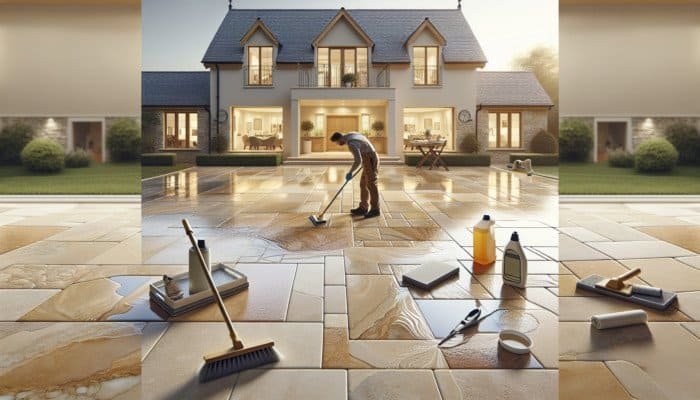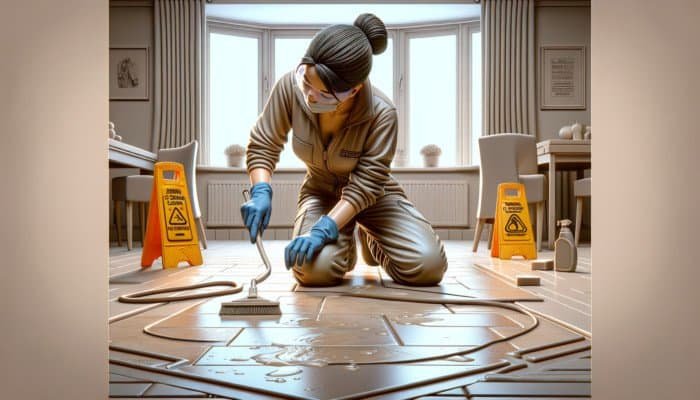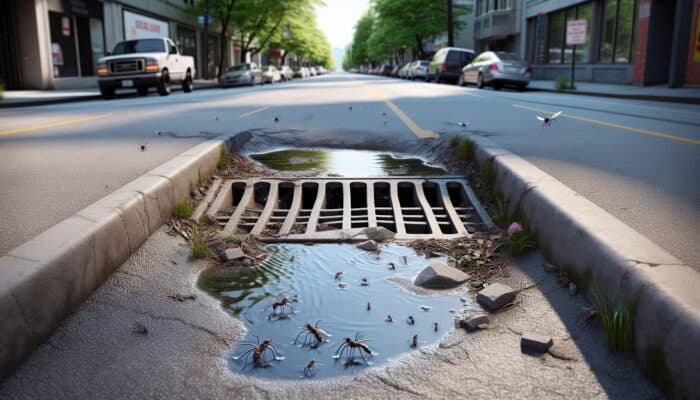Master the Art of Cleaning Travertine: Discover Key Insights and Essential Strategies for Optimal Care:
- Travertine is a breathtaking natural stone celebrated for its exquisite elegance, yet it requires specialised care to preserve its enchanting beauty.
- This in-depth guide provides invaluable knowledge encompassing everything from day-to-day cleaning practices to effectively tackling stubborn stains.
- Understand which tools and cleaning agents are safe for your travertine, alongside those that should be avoided to safeguard your investment.
- Safeguard your stone by adhering to expert recommendations on sealing, drying, and preventing irreversible damage.
- Ideal for both homeowners and professionals, whether you’re maintaining elegant countertops or pristine bathroom surfaces.
Uncover the Diverse Uses of Travertine in Homes Across the UK
Travertine is a remarkable natural stone formed from mineral deposits in hot springs, renowned for its distinctive beauty and unique characteristics. Its increasing popularity within UK homes stems from its versatility and timeless elegance, making it a superb choice for both decorative and functional applications. This extensive exploration will investigate the various types of travertine found in UK residences, its myriad benefits, common challenges homeowners might face, and essential maintenance techniques to ensure it retains its beauty and functionality over time.
Deepen Your Understanding of the Various Types of Travertine Available for Your Home

In the UK, travertine is offered in a diverse range of varieties, each characterised by its unique colour, texture, and finish. The primary categories include filled and unfilled travertine. Filled travertine has been treated to seal its natural voids, resulting in a smoother surface that is ideal for high-traffic areas. In contrast, unfilled travertine preserves its natural texture, making it a preferred option for outdoor spaces such as gardens and patios, where it imparts a rustic charm. Understanding these classifications is crucial, as each type has specific cleaning requirements. For instance, filled travertine is generally more straightforward to maintain due to its smooth finish, while unfilled travertine may trap dirt and grime in its natural cavities, necessitating a more thorough cleaning approach.
Another significant distinction lies in the finishes available: honed versus polished. Honed travertine features a matte finish, rendering it practical for everyday use. Conversely, polished travertine exhibits a glossy surface that enhances colour vibrancy but may be more susceptible to scratching and etching from acidic substances. Recognising the specific type of travertine in your home can greatly influence your cleaning methods, assisting you in maintaining its stunning beauty without causing any damage.
Explore the Many Benefits of Choosing Travertine for Your Home
Travertine boasts a multitude of advantages, establishing it as an exceptional choice for any UK residence. Primarily, its aesthetic appeal is striking; the natural variations in colour and texture foster a warm and inviting atmosphere. Whether employed for <a href=”https://limitsofstrategy.com/budget-friendly-ceramic-tile-flooring-in-east-dunbartonshire/”>flooring</a>, countertops, or wall cladding, travertine imparts a touch of luxury to any environment. Beyond its visual allure, travertine is remarkably durable. With appropriate care, it can endure the rigours of daily life, making it suitable for both residential and commercial settings.
Furthermore, travertine acts as a natural insulator, aiding in temperature regulation and enhancing energy efficiency within homes. In colder months, travertine retains heat, while in warmer seasons, it remains cool to the touch, ensuring comfort throughout the year. Additionally, it represents an environmentally sustainable choice; as a natural stone, it is far more eco-friendly compared to synthetic alternatives, aligning with contemporary sustainability practices.
Another notable advantage of travertine is its versatility. It complements a wide array of design styles, from traditional to contemporary, empowering homeowners to express their unique aesthetics. Moreover, travertine is suitable for both indoor and outdoor applications, facilitating a seamless design flow across various sections of the home.
Recognise Common Challenges Faced by Travertine Owners
Despite its numerous benefits, travertine is not without its challenges. A common issue encountered by UK homeowners is staining. Due to its porous nature, travertine can readily absorb spills from liquids such as coffee, wine, or cleaning agents. If these stains go unaddressed, they can significantly affect the stone’s appearance. Additionally, etching may occur when acidic materials come into contact with travertine, leading to dull patches that detract from its beauty.
Another concern is the potential for discolouration over time, especially in high-traffic areas or locations exposed to sunlight. This discolouration can give the stone a worn appearance, even if its structural integrity remains intact. Furthermore, the grout lines found in travertine installations may become stained or develop mould, requiring extra attention during cleaning.
In the UK, fluctuating weather conditions and indoor humidity can also promote the growth of mould or mildew on travertine surfaces, particularly in bathrooms or kitchens. Acknowledging these challenges is essential for homeowners, as it enables them to take proactive steps to prevent long-term damage to their travertine installations.
Adopt Effective Maintenance Strategies for Your Travertine

Establishing a consistent maintenance routine is vital to ensure that travertine in UK homes retains its pristine condition. Initially, it is essential to implement a cleaning regimen. Regularly employing a soft-bristled broom or a vacuum cleaner will aid in eliminating dust and dirt on a daily basis. Mopping with a pH-neutral cleaner specifically formulated for natural stone will help maintain its shine without causing harm to the surface.
In addition to routine cleaning, homeowners should contemplate applying a sealant to their travertine surfaces. Sealing provides a protective barrier against stains and moisture, extending the stone’s lifespan. In the UK, resealing should be scheduled every one to three years, depending on the level of usage and exposure to the elements.
Lastly, it is crucial to address any stains or discolouration as soon as they arise. A straightforward mixture of baking soda and water can be effective for minor stains. However, for deeper, more stubborn stains, professional cleaning services may be necessary to restore the stone’s original beauty and integrity.
Overall, a comprehensive understanding of travertine’s characteristics combined with a robust maintenance routine will ensure it remains a stunning focal point in UK homes for many years to come.
Utilise This Step-by-Step Guide for Efficiently Cleaning Travertine Surfaces
Proper preparation is essential for achieving optimal results when cleaning travertine surfaces. This section outlines the necessary steps, from gathering required supplies to ensuring safety and conducting pre-cleaning inspections, to facilitate a successful cleaning experience in UK homes.
Gather Essential Supplies for Effective Travertine Cleaning
When cleaning travertine, having the right supplies at your disposal is crucial. Homeowners can discover numerous effective cleaning products at UK retailers specifically designed for the care of natural stone. Start with a pH-neutral cleaner, as harsh chemicals can damage the stone’s surface. Reputable brands such as Lithofin and GranQuartz provide excellent options tailored to the unique properties of travertine.
In addition to a suitable cleaner, homeowners will require soft cloths or mops to prevent scratching the surface during cleaning. Microfiber cloths are particularly effective as they are gentle yet efficient at capturing dust and grime. A soft-bristled broom or vacuum cleaner is also indispensable for daily maintenance.
Having baking soda and water readily available is beneficial for addressing stains, as this mixture can effectively lift minor stains without harming the travertine. Furthermore, it may be worthwhile to invest in a high-quality stone sealer suitable for both indoor and outdoor use, ensuring that your travertine surfaces remain protected long after cleaning procedures are completed.
Prioritise Safety Precautions During the Cleaning Process

Safety should always be a top priority when cleaning travertine in UK homes. It is advisable to wear appropriate personal protective equipment, such as gloves and eye protection, especially when handling cleaning products. Ensure that the cleaning area is well-ventilated to avoid inhaling fumes, particularly if using commercial cleaners containing potent chemicals.
Testing any cleaning solution on a small, inconspicuous area before applying it to the entire surface is also critical. This precaution ensures that the product does not cause discolouration or damage to the travertine. Additionally, be mindful of wet floors to minimise the risk of slipping; consider placing warning signs or barriers around the cleaning area as necessary.
If faced with heavy stains or extensive cleaning tasks, seeking professional assistance may be advantageous. Experienced cleaners understand the specific needs of travertine and can provide tailored solutions while ensuring that safety standards are adhered to throughout the cleaning process.
Conduct a Thorough Pre-Cleaning Inspection of Travertine Surfaces
Before beginning the cleaning process, it is vital to carry out a comprehensive inspection of the travertine surfaces. Start by assessing the overall condition of the stone, looking for cracks, chips, or signs of wear. Addressing these issues early can help prevent further damage during cleaning and maintenance.
Next, identify which areas require special attention. For example, high-traffic zones may need more thorough cleaning than less-frequented sections. Take note of any persistent stains or discolouration that may require special treatment or professional assistance.
Lastly, consider the surrounding environment. Ensure that furniture and decorative items are removed from the cleaning area to prevent damage. Preparing the area this way will streamline the cleaning process and contribute to more effective outcomes, resulting in beautifully maintained travertine surfaces.
Learn Proven Techniques for Cleaning Travertine Floors Effectively
Cleaning travertine floors requires a thoughtful approach to retain their beauty and durability. This section explores daily maintenance routines, effective deep cleaning techniques, strategies for stain removal, the significance of sealing, and methods for repairing any damage that may occur in UK homes.
Establish a Consistent Daily Maintenance Routine for Travertine Floors
Maintaining travertine floors daily is vital for prolonging their lifespan and keeping them looking their best. Begin by sweeping or vacuuming regularly to remove dirt and debris that can lead to scratches. A soft-bristled broom or a vacuum cleaner equipped with a hard floor attachment is ideal, as it will not damage the surface. Sweeping should be followed by mopping as the next critical step. Use a pH-neutral cleaner mixed with warm water to create a gentle cleaning solution. Employ a damp mop—avoiding soaking the floor, as excess water can seep into the porous travertine and cause damage over time. Aim to mop at least once a week, or more frequently in high-traffic areas, to prevent dirt accumulation.
Furthermore, placing mats or rugs at entry points can significantly minimise the amount of dirt and grit that gets onto your travertine floors. Regularly cleaning these mats will enhance your daily maintenance routine, ensuring your floors remain clean and inviting.
Implement Effective Deep Cleaning Techniques for Travertine Floors
While daily upkeep is essential, periodic deep cleaning is necessary to keep travertine floors in top condition. Start by removing furniture and items from the floor to provide complete access for cleaning. Next, vacuum thoroughly to eliminate accumulated dirt and dust.
For deep cleaning, apply a mixture of warm water and a pH-neutral cleaner with a mop. Avoid acidic or abrasive cleaners, as they can etch the stone and lead to dullness. A poultice made from baking soda and water can be applied to stubborn stains, left to sit for several hours, and then gently scrubbed off.
If your travertine floors are heavily soiled, consider using a steam cleaner specifically designed for natural stone. This approach can effectively lift dirt and grime without the need for harsh chemicals. However, exercise caution and ensure the steam cleaner is compatible with travertine, as excessive heat can damage the stone if not used properly.
Utilise Effective Stain Removal Techniques for Travertine Floors
Stains on travertine floors can be frustrating for homeowners. To prevent spills from setting in, prompt action is essential when addressing them. For minor stains, create a paste from baking soda and water, apply it to the stain, and allow it to sit for a few hours before wiping clean.
A commercial stone cleaner may be required for more stubborn stains, such as oil or wine. Always follow the manufacturer’s instructions and test the product on a small area first. In certain situations, it may be beneficial to enlist professional assistance, particularly for deep-set stains that require advanced removal techniques.
Moreover, incorporating preventative measures into your routine, such as using coasters under beverages and promptly cleaning up spills, can save you time and effort when managing potential stains on your travertine floors.
Understand the Importance of Sealing Travertine Floors
Sealing travertine floors is a critical aspect of ongoing maintenance, providing a protective layer against stains and wear. In the UK, sealing is recommended every one to three years, depending on foot traffic and exposure to moisture. A high-quality stone sealer penetrates the porous surface, preventing liquids from being absorbed and causing stains.
Before applying a sealer, ensure the floor is thoroughly cleaned and completely dry. Use a soft cloth or roller to apply the sealer according to the manufacturer’s instructions. Be mindful to cover the entire surface evenly to avoid streaks or missed areas.
After sealing, allowing the product to cure adequately is crucial. Depending on the specific product used, this may take anywhere from a few hours to several days. To ensure optimal results, avoid mopping or exposing the floor to water during this curing period. Regularly sealing your travertine floors enhances their durability and preserves their natural beauty.
Effectively Repair Damaged Travertine Floors
Even with the best care, chips and cracks can occur in travertine floors. Addressing these issues promptly is vital to maintaining the stone’s aesthetic appeal. Many UK home improvement stores offer a travertine repair kit for minor chips, which typically contains epoxy resin and colour-matching powder, enabling homeowners to seamlessly fill the damaged area.
For larger cracks, consulting a professional may be advisable. Experts can assess the damage and recommend the most appropriate course of action, whether it involves a simple fix or a more extensive restoration. Additionally, regular inspections will help identify any damage early, preventing further deterioration.
When undertaking travertine repairs, ensure that the surrounding area is clean and dry to promote proper adhesion. After completing the repair, allow sufficient time for the materials to cure before resuming regular floor use. With timely maintenance, you can preserve the beauty and longevity of your travertine floors.
Implement Effective Strategies for Cleaning Travertine Walls
Travertine walls can dramatically enhance the elegance of any space, but they require regular cleaning and maintenance to keep them looking their best. This section outlines routine cleaning methods, strategies for tackling grime buildup, and polishing techniques to ensure your travertine walls remain stunning in UK homes.
Create a Regular Cleaning Regimen for Travertine Walls
Regular cleaning of travertine walls is essential for preserving their beauty and preventing grime accumulation. Start by dusting the walls with a soft cloth or using a duster to remove cobwebs or dust particles. This preliminary step helps to avoid dirt being ground into the stone during the cleaning process.
Next, prepare a cleaning solution by mixing warm water with a pH-neutral cleaner. Using a soft sponge or cloth, gently wipe down the travertine surface, ensuring not to saturate the stone. It is crucial to avoid acidic cleaners or harsh chemicals, which can etch and damage the stone’s finish.
For areas that experience higher moisture levels, such as bathrooms, consider implementing a cleaning routine that includes wiping down the walls after each use. This practice helps to prevent the buildup of soap scum and mildew, keeping your travertine walls looking fresh and clean.
How to Tackle Grime Buildup on Travertine Walls?
Over time, grime can accumulate on travertine walls, particularly in areas exposed to moisture or cooking vapours. To address this buildup, begin with a thorough inspection of the affected areas. For light grime, a mixture of warm water and a few drops of dish soap can lift dirt without harming the stone.
For tougher grime, consider using a stone-safe degreaser. Apply the product according to the manufacturer’s instructions, allowing it to sit for a few minutes to break down the soil. Use a soft-bristled brush or sponge to gently scrub the area, rinsing with clean water to remove any residue.
If mildew or mould is present, a diluted solution of water and white vinegar can be effective. However, it is imperative to test this on a small, inconspicuous area first, as vinegar can damage the finish on polished travertine. Once cleaned, ensure the area is thoroughly dried to prevent future growth.
Apply Polishing Techniques for Travertine Walls
Regular polishing is recommended to maintain the shine of travertine walls. Begin by ensuring that the walls are clean and free from dust and grime. A specially formulated stone polish compatible with travertine is ideal for this purpose; these products are widely available in UK home improvement stores.
Apply the polish using a soft cloth or applicator pad, working in small sections and buffing the surface gently in circular motions. This technique enhances the shine and helps to fill in minor scratches, improving the overall appearance of the wall.
Consider polishing your travertine walls every 6-12 months, depending on exposure to dirt and moisture. This routine will help preserve their beauty and ensure they remain a stunning feature in your home.
Cleaning and Maintaining Travertine Countertops with Care
Travertine countertops are a luxurious addition to any kitchen or bathroom, but they require careful maintenance to remain immaculate. This section discusses everyday cleaning practices, prompt spill response strategies, and techniques for restoring the shine of travertine countertops in UK homes.
Establish an Everyday Cleaning Routine for Travertine Countertops
A consistent daily cleaning routine is vital for maintaining the beauty of travertine countertops. To remove crumbs and spills, begin by wiping the surface with a damp cloth or sponge. A soft cloth helps avoid scratching the stone while ensuring food particles do not accumulate.
For deeper cleaning, opt for a pH-neutral cleaner explicitly formulated for natural stone. Apply the cleaner using a soft cloth, following the manufacturer’s instructions. Rinse thoroughly with warm water to eliminate any residue that could dull the surface over time.
It is advisable to clean countertops after each use, particularly in kitchens where spills are common. Regular maintenance keeps the surface looking great and helps prevent staining and etching from acidic substances, which can be detrimental to travertine.
What Immediate Action Should You Take on Spills on Travertine Countertops?
Quick action is critical when it comes to spills on travertine countertops. Whether it’s wine, sauce, or acidic substances like lemon juice, immediate cleaning can prevent stains or etching. Blot the area with a soft cloth for liquid spills to absorb as much liquid as possible. Avoid wiping, as this can spread the spill and increase the risk of staining.
A poultice made from baking soda and water can be applied for spills that have already set in. Cover the area with plastic wrap and allow it to sit for 24 hours to absorb the stain. Afterwards, gently scrub the area with a soft cloth and rinse with warm water.
Preventing spills is equally essential. Using coasters under beverages and avoiding placing acidic foods directly on the countertop can substantially reduce the risk of damage. Proactively caring for your travertine countertops will ensure they remain beautiful in your home.
How to Restore the Shine of Travertine Countertops?
Over time, travertine countertops can lose their lustrous shine due to daily wear and tear. To restore their original beauty, thoroughly clean the surface to remove dirt and grime. After cleaning, apply a stone polish designed explicitly for travertine. These polishes are readily available in many UK stores and can significantly enhance the natural sheen of the stone.
Apply the polish in small sections using a soft cloth or applicator pad, buffing in circular motions. This process helps fill in micro-scratches and improves the stone’s overall surface. Allow the polish to dry according to the manufacturer’s instructions, typically around 30 minutes.
For long-lasting results, consider sealing your countertops after polishing. Sealing creates a protective barrier that helps maintain shine and prevent stains, ensuring that your travertine countertops remain a stunning focal point in your kitchen or bathroom.
Cleaning and Maintaining Outdoor Travertine Surfaces Effectively
Outdoor travertine surfaces, such as patios and pathways, require consistent care to withstand the elements while retaining their beauty. This section discusses effective cleaning and maintenance strategies for outdoor travertine, how to protect it from adverse weather conditions, and how to implement seasonal maintenance routines in UK gardens.
How to Maintain Outdoor Patios and Pathways with Care?
Given their exposure to the elements, cleaning outdoor travertine patios and pathways requires a slightly different approach than that used for indoor surfaces. Begin by clearing the area of any furniture and debris. A leaf blower or broom can effectively remove leaves, dirt, and other loose materials.
For regular cleaning, mix warm water with a pH-neutral cleaner and gently scrub the surface with a soft-bristled broom. Pay special attention to areas where grime tends to build up. Rinse thoroughly with a hose to ensure that no cleaning residue remains on the stone.
For a more comprehensive deep clean, particularly in the spring, consider using a pressure washer fitted with a wide nozzle. However, exercise caution when setting the pressure; too high can damage the stone. Always test the pressure washer on a small area first to ensure the safety of your travertine.
What Measures Can You Take to Protect Outdoor Travertine from Weather Elements?
Safeguarding outdoor travertine from UK weather conditions is essential for maintaining its appearance and longevity. One of the most effective methods of protecting your travertine is through sealing. A high-quality stone sealer creates a barrier against moisture and prevents staining from rain and snow.
Additionally, consider placing outdoor mats or rugs in high-traffic areas to minimise wear and tear. These mats can be easily cleaned and help capture dirt before it contacts the travertine surface.
During colder months, take precautions to prevent frost damage by promptly removing any standing water. Ice can cause cracking or compromise the integrity of the stone, making it essential to keep surfaces dry throughout the winter for long-term maintenance.
Implement Seasonal Maintenance for Outdoor Travertine Surfaces
Seasonal maintenance is crucial for preserving outdoor travertine surfaces throughout the year. In spring and autumn, conduct a thorough cleaning to eliminate debris from seasonal changes. This is also an excellent opportunity to inspect your travertine for any signs of wear or damage.
During the summer, remain vigilant about grime and mildew, especially in shaded areas where moisture can linger. Regular cleaning and using a mildew-preventative solution can help keep your surfaces immaculate.
In winter, regular snow and ice removal is critical. Use a plastic shovel to avoid scratching the surface, and refrain from using rock salt, which can damage natural stone. By implementing these seasonal routines, you can ensure your outdoor travertine remains a beautiful feature of your garden for many years to come.
Consider Engaging Professional Cleaning Services for Travertine in the UK
While regular cleaning and maintenance are essential for travertine surfaces, there may come a time when hiring professional cleaning services becomes necessary. This section discusses when to seek professional assistance, how to select the right service, and what to expect during a professional cleaning session in UK homes.
How to Determine the Right Time to Hire Professionals for Travertine Care?
Homeowners should consider enlisting professional cleaning services when confronted with extensive stains, heavy grime buildup, or significant damage to their travertine surfaces. If routine cleaning efforts fail to restore the stone’s luster or persistent discolouration becomes apparent, it is wise to consult an expert.
Additionally, professional cleaning is recommended for larger areas, such as extensive outdoor patios or commercial spaces. These professionals possess advanced equipment and specialised products that can achieve results far superior to what is possible with standard household cleaners.
If you are uncertain about the appropriate cleaning methods or products to use, seeking professional guidance is advisable. Experts can assess your travertine’s condition and recommend tailored solutions that ensure its longevity and aesthetic appeal.
How to Select the Most Suitable Cleaning Service for Your Needs?
When choosing a professional travertine cleaning service in the UK, conducting thorough research is essential. Start by asking for recommendations from friends, family, or neighbours who have previously utilised such services. Look for companies that specialise in stone care and boast a solid reputation within the community.
Read online reviews and testimonials to gauge customer satisfaction and the quality of their work. It’s also advisable to inquire about their cleaning methods and products to ensure they align with your preferences, particularly regarding the use of non-toxic and environmentally friendly cleaners.
Once you’ve narrowed your options, request quotes to compare pricing and the services offered. A reputable company should provide a clear understanding of what their services entail, including timelines and any warranties or guarantees on their work.
What to Expect During a Professional Cleaning Session for Travertine?
During a professional travertine cleaning session, homeowners can anticipate a thorough inspection of their surfaces before cleaning begins. The technician will assess the stone for any damage, stains, or areas requiring special attention.
The cleaning process will generally involve a deep clean using specialised equipment and products tailored for travertine. This specialised cleaning may include steam cleaning, scrubbing, or the application of a poultice for stain removal. Homeowners should be informed about each step to ensure transparency and satisfaction.
Upon completion of the cleaning, the technician may recommend sealing the stone for added protection. Homeowners can expect to receive care instructions and maintenance tips to help them preserve their travertine surfaces in the future. Engaging professional services can significantly enhance the beauty and longevity of travertine in UK homes.
Implement Long-Term Strategies for Maintaining Travertine in UK Homes
Ongoing maintenance of travertine surfaces is crucial for preserving their beauty and functionality over time. This section highlights preventive measures homeowners can implement to keep travertine surfaces in optimal condition, ensuring they remain a stunning feature in UK residences.
How to Establish Effective Preventive Measures for Travertine Longevity?
Establishing preventive measures is vital for maintaining travertine surfaces. Begin by implementing a routine that includes regular dusting and mopping with pH-neutral cleaners. This practice helps prevent the accumulation of dirt and stains from setting in.
Utilising coasters under beverages and placing mats at entry points will significantly reduce the risk of scratches and stains. In kitchens, use cutting boards and avoid placing hot pots directly on the surface to prevent etching and other damage.
Consider scheduling professional cleanings every few years, especially in high-traffic areas. These services will provide deep cleaning and resealing of your travertine, ensuring its longevity. By prioritising preventive maintenance, UK homeowners can enjoy the beauty of their travertine surfaces for many years to come.
Address Common Questions about Travertine Maintenance
What is the recommended cleaning frequency for travertine floors?
Travertine floors should be cleaned regularly, with a deeper clean scheduled weekly to maintain their appearance.
Can I safely use vinegar to clean travertine?
It’s best to avoid vinegar due to its acidity, which can etch and damage travertine surfaces. Instead, opt for pH-neutral cleaners specifically formulated for stone.
What is the most effective method for removing stains from travertine?
Utilise a baking soda paste for minor stains or seek professional assistance for tough, deep-set stains that require more advanced techniques for removal.
How can I protect my outdoor travertine from winter weather conditions?
Seal your outdoor travertine and promptly remove snow and ice using a plastic shovel to prevent scratching and potential damage.
What type of sealer is considered best for travertine surfaces?
A high-quality, breathable stone sealer designed explicitly for travertine is ideal for protecting against stains and moisture infiltration.
Can I polish my travertine countertops on my own?
To restore travertine’s shine and enhance its appearance, you can apply a stone polish formulated for it using a soft cloth.
How do I prevent mould from forming on my travertine walls?
Regularly clean your travertine walls and ensure they are well-ventilated to inhibit moisture buildup, which can lead to mould growth.
Is it safe to use a pressure washer on my outdoor travertine surfaces?
Yes, but ensure you use a low-pressure setting and a wide nozzle to prevent damage to the stone during the cleaning process.
How frequently should I reseal my travertine surfaces?
Resealing should occur every one to three years, depending on the foot traffic level and moisture exposure of your surfaces.
What should I do if my travertine is chipped or damaged?
For minor chips, utilise a repair kit. For more significant damage, consult a professional stone restoration service to ensure proper repair techniques are used.
The post Master the Art of Cleaning Travertine: Discover Key Insights and Essential Strategies for Optimal Care appeared first on https://tilecleaningsurrey.co.uk
The Article Cleaning Travertine: Your Essential Guide for Best Results appeared first on https://fabritec.org
The Article Cleaning Travertine: The Ultimate Tips for Top Results Was Found On https://limitsofstrategy.com



